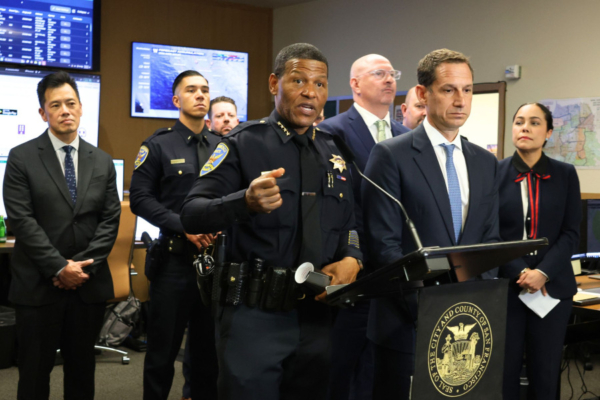San Francisco is enhancing law enforcement efficiency through “technology policing,” significantly reducing crime rates. On April 9, 2025, during the National Crime Victims’ Rights Week, the San Francisco Police Department (SFPD) held a press conference at its Real-Time Intelligence Center (RTIC) to announce their interim results.
Mayor Daniel Lurie stated during the conference, “In the first quarter of this year, property crime rates citywide decreased by 35% compared to last year, violent crime decreased by 15%, and vehicle burglary cases hit a 22-year low.”
Since the launch of RTIC in 2024, the police have assisted in the apprehension of over 500 suspects, with undercover police teams being the “main force” in carrying out missions.
Located on the fifth floor of the Thomas J. Cahill Hall of Justice in San Francisco, the center integrates data from the city’s 400 Automatic License Plate Recognition (ALPR) locations, 10 precincts’ Drones as First Responders (DFR) units, surveillance cameras, and other sources to deliver crucial intelligence to frontline officers in real-time, increasing law enforcement speed and accuracy while reducing the risks of high-speed pursuits.
The system’s advantages lie in “early warning” and “rapid response.” At the press conference, the police showcased video footage of an RTIC-assisted case: a stolen vehicle appeared in downtown San Francisco, triggering an alert from the ALPR system, prompting immediate drone deployment. Despite the suspect changing license plates to evade detection, they were unknowingly recorded by drones throughout. Once the new license plate number was obtained, undercover police were dispatched and successfully apprehended the suspect nearby within less than an hour.
Explaining that under traditional law enforcement methods, such cases often required days to weeks of investigation, as “even if the police checked, they would only find that it was a stolen license plate,” and the suspect could potentially commit multiple crimes that day, such as car theft, robbery, and retail theft. Each crime would need individual investigation and reports. Now, by utilizing RTIC to integrate data and video records, the police can not only prevent subsequent crimes but also investigate all related crimes together, submitting a single set of data for prosecutorial review.
San Francisco Police Chief William Bill Scott stated that RTIC has brought a “multiplier effect” to both police department and city safety.
He mentioned that the city is currently short of 500 police officers. However, RTIC’s technology significantly reduces case processing time, freeing up more manpower for law enforcement.
Lurie noted that over the years, San Francisco has lagged behind other law enforcement agencies in technology policing, including some private areas within the city. “RTIC is not just a new tool for the city’s police department but also a turning point for urban security,” he mentioned. “As we continue to work on supplementing police manpower, we must also make good use of all available resources to protect the citizens.”
Besides homicide, robbery, home invasion, car theft, and general theft, RTIC can assist in disaster relief, locating missing persons, and handling psychological crises.
Furthermore, RTIC technology helps reduce false arrests. In the past, innocent individuals were briefly detained due to resemblances, but the data and image records from RTIC provide concrete evidence, exonerating the innocent.
The police revealed that since the launch of RTIC, more and more individuals are applying to join the San Francisco Police, including “current police officers from the Bay Area and farther regions.”
In recent years, San Francisco has been plagued by high crime rates, especially in car break-ins, retail theft, and robberies, leading to business closures, a decline in tourism, and concerns over public safety by residents and businesses.
To address this situation, last year, the city government passed Proposition E, easing restrictions on law enforcement to utilize technology devices, approving the expanded use of drones, ALPR, and real-time monitoring technology by the police department.
To respond more swiftly to crime incidents, the police mentioned that they are building a citywide “real-time response network.”
Chief Scott clarified that the current RTIC system does not incorporate generative artificial intelligence technology; all decisions are made by human interpretation. However, he predicted that AI will inevitably become more ingrained in law enforcement, stating that “clear standards need to be established for its adoption.”

